Next year, Star Trek is fifty years old. We have some special stuff planned for that, but – in the meantime – we’re reviewing all of Star Trek: Enterprise this year as something of a prequel to that anniversary. This August, we’re doing the third season. Check back daily for the latest review.
Star Trek: Enterprise spent a lot of the final stretch of the third season playing at being Star Trek: Deep Space Nine. There are a number of episodes that provide a direct parallel with stories from that earlier underrated Star Trek show. Damage riffs on In the Pale Moonlight. E² is very much Children of Time. More than that, the moral ambiguity and the long-form storytelling that define the third season of Enterprise also owe a very conscious debt to the work done on Deep Space Nine.
However, the final two episodes of the third season drift away from the ethical uncertainties and moral quagmires that defined a lot of the year’s stories. The Council effective resolved the big thematic questions hanging over the third season, allowing Archer the chance to propose a diplomatic solution to the Xindi crisis. This allows Countdown and Zero Hour to go about the task of providing a suitably impressive action climax to this twenty-four-episode season-long arc. There is precious little soul-searching here; instead, there is one big race against time.
In that respect, the last two episodes of the third season hark back to a more traditional form of Star Trek storytelling. In particular, Countdown and Zero Hour feel like an old-school blockbuster two-parter, in the style of Star Trek: The Next Generation or Star Trek: Voyager. In fact, with Archer’s fate in question and a hostile unstoppable force invading the solar system only to be destroyed in orbit of Earth, Countdown and Zero Hour play like an extended homage to The Best of Both Worlds.
While one of the most frequent criticisms of Enterprise is the sense that the writing staff are simply regurgitating classic Next Generation and Voyager plots, this feels almost earned. The third season has largely been about the show’s journey back to the heart of the Star Trek franchise, a trip that concluded with Archer embracing traditional Star Trek values in The Council. But what fun is that journey if you don’t get to celebrate it with an epic high-stakes world-ending rollercoaster ride?
There is a sense that the demands of the network played a part in the structure of the season, with the actual thematic conclusion to the arc unfolding three episodes from the end of the season to make room for a two-episode chase sequence. The four-year run of Enterprise is largely defined by conflicts between the network and the production team about the best direction for the show. UPN had changed ownership at the end of the show’s first year, and the new management were not particularly interested in the classic Star Trek aesthetic.
In fact, certain plot points of Countdown and Zero Hour were a source of friction between Rick Berman and the network. With the third season coming to a close, the network had advocated that Jonathan Archer should die at the climax of Zero Hour. The idea was that Archer would sacrifice himself to save the world, and that would allow UPN to cast a younger and hipper actor to headline the show. This gives an example of the sort of heated debate taking place behind the scenes.
UPN very clearly wanted a version of Star Trek that skewed younger. They wanted a sexier action-driven show. In an interview earlier in the season, John Billingsley suggested that a large part of the change to the show’s aesthetic came from the network:
“The only thing that has become more and more apparent with time is that the powers that be would really like to see the show appeal to a broader audience, so have upped the action adventure quotient more and more has time has passed, particularly this season.”
Of course, there is no indication that UPN actually wanted to make the show workable. There was the suggestion that the network was actively hostile to the show, with many commentators speculating that the third season might be the last season of Star Trek to air for a very long time.
Both Countdown and Zero Hour are action-packed hours of television, with an obvious sense of mounting tension and impossibly high stakes. They capture a lot of the excitement of the strongest Next Generation or Voyager two-parters, working as a fine example of pulpy television science-fiction. After all, the third season culminates on Archer defeating a genocidal lizard man atop a giant laser before blowing up what is effective the Death Star. It is very silly, but no less enjoyable for that.
From a strictly plotting perspective, Countdown and Zero Hour makes the very clever decision to split the crew. it is a storytelling technique that works very well at raising the tension; it is model that is perhaps typified by the structure and rhythm of Star Wars: The Empire Strikes Back. While Archer takes a team to destroy the weapon itself, T’Pol leads the Enterprise in a mission to destroy the Spheres that will soon render the galaxy uninhabitable.
This is a very clever climax to the season. So much of the third season is predicated on the threat to Earth itself, and Archer gets to deal with that. However, it is also nice to see the franchise embracing a broader perspective. T’Pol makes the stakes quite clear to Trip in Zero Hour. “Without humanity there’s no one to combat these Sphere Builders,” T’Pol advises the Chief Engineer. “Their Expanse will continue to grow, encompassing one system after another, including Vulcan. Your world is no longer the only one in jeopardy.”
Not only does it represent a palpable escalation in the stakes of the season, but it also hints at the idea of co-dependency and mutual cooperation that underpins the Star Trek franchise. The third season might have begun as a one-ship mission “going it alone” to save Earth because none of its allies were willing to assist, but it ends with the franchise closer to a broader universal perspective than ever before. After all, Shran plays a pretty significant role on Archer’s mission to save the planet in Zero Hour. Consensus and cooperation are still key Star Trek values.
The moral complexity that defined most of the third season is largely absent from Countdown and Zero Hour. While the portrayal of the reptile!Xindi as two-dimensional villains undermined a lot of the ambiguity around earlier episodes in the season, it works surprisingly well in the context of Countdown and Zero Hour. Whether eating live mice or taking time out from his busy schedule to blow up an unarmed scientific outpost, Dolim seems ready to break out into a maniacal laugh at the earliest possible opportunity.
Even his torture of Hoshi seems to exist as confirmation that the traditional moral ordering of the Star Trek franchise has been restored. Torture is unjustifiable and horrific. Archer resorted to it in Anomaly, much like he resorted to piracy in Damage. The climax of the third season made it clear that such actions only lead to self-perpetuating cycles of abuse. The torture of Hoshi at the hands of the reptile!Xindi makes it clear that torture is an abhorrent act within the moral framework of the Star Trek universe. It affirms that Dolim is a two-dimensional bad guy.
To be fair, even Dolim’s character design screams “comic book villain.” His green and purple colour scheme, reflected in the design and lighting on the weapon itself, has always been visual shorthand for “baddie.” Dolim looks like he belongs in a line up with Victor Von Doom, Lex Luther, the Joker, the Green Goblin, the Riddler, Mysterio, the Lizard, Maleficent or Baron Samedi. In terms of pulpy genre entertainment, secondary colours like green and purple have long been a visual indication of a character’s evil nature. (Primary colours are associated with heroes.)
While the fact that Dolim was a card-carrying villain undercut some of the core themes running through the season, it does mean that Countdown and Zero Hour are allowed to run like clockwork. Dolim is the perfect antagonist for a bombastic two-part action adventure designed to close out the year, particularly with Enterprise embracing its pulpier side. The only way that Zero Hour could possibly trump the sheer pulp of Archer wrestling with an evil lizard man atop a giant bomb orbiting the Earth would be to somehow shoehorn in evil alien space Nazis.
To be fair, the entire make-up and production design of the Xindi embraces a pulpy science-fiction sensibility, with insect people and lizard people. It is all top-notch, and testament to everybody involved in the production. The production team on the Star Trek franchise seldom get the credit that they deserve for realising all these alien species and cultures week in and week out. While the special effects that realise the insect!Xindi and the aquatic!Xindi have dated somewhat in the years since broadcast, they remain impressive in the context of the time.
The aquatic!Xindi come into focus during the final three episodes of the season, and are consciously presented in a way that evokes the Guild Navigators from Dune; they sit in their tanks and seem to provide the transport infrastructure for the Xindi as a whole. Tellingly, Archer’s first encounter with the aquatic!Xindi comes when they shepherd him back to Enterprise in Damage, while they also help to transport Enterprise itself in both Countdown and Zero Hour. It feels like Star Trek is allowing itself to embrace a goofier science-fiction aesthetic.
Even allowing for the fact that Dolim is a fifties b-movie baddie, Scott MacDonald does tremendous work as Dolim. It is quite clear that the actor is relishing every moment that he is on the show, with his wonderfully deep voice and slightly sinister lisp forced by the prosthetic teeth. Dolim is not a character who will garner the same sort of attention and praise that accrues to characters like those played by Jeffrey Combs. At the same time, MacDonald does a tremendous job realising what is basically and unapologetically a two-dimensional villain.
When Enterprise launched, there was a lot of talk about getting back to the rough and ready aesthetic of the classic Star Trek. In the first season, episodes like Civilisation were very clearly an attempt to position Jonathan Archer as a modern-day incarnation of James Tiberius Kirk – wrestling with evil aliens and hooking up with hot alien cheeks. At the same time, it seemed like the first two seasons were a little embarrassed by the goofier and sillier side of Kirk’s adventuring, and so Archer’s two-fisted action generally felt rather bland and generic.
After a season of picking Jonathan Archer apart and putting him through horrific moral decisions, it feels entirely appropriate that Countdown and Zero Hour mostly just let him get his action hero on. The climax of Zero Hour looks completely ridiculous as piece of contemporary television, as Archer grapples with a dude in purple robes wearing a bird-cage as shoulder pads. However, most of Kirk’s action sequences looked equally ridiculous – from wrestling with the Gorn in Arena to going mano a mano with Khan in Space Seed.
However, the original Star Trek had an enthusiasm and energy that carried those moments, along with the occasional patented Shatner roll. It never mattered that the silly green lizard suit didn’t look a lizard man; it was something into which the production team put a tremendous amount of work, and to which the show appreciated enough to commit. Since the early days of The Next Generation, it has seemed like the Star Trek franchise has been a little embarrassed by those pulpier tendencies and has worked hard to ensure that it is taken seriously.
There are exceptions, of course. Brannon Braga has a clear appreciation for a goofy science-fiction premise, as scripts like Genesis, Threshold and Macrocosm will attest. Nevertheless, The Next Generation and Voyager were both shows that worked hard to conform to the expectations of serious prime time television. Rick Berman was very much an arbitrator of taste here, insisting that the composers tone down the soundtracks and refusing to allow the Andorians to appear on Deep Space Nine.
With Enterprise, it seems like the production team has been allowed to relax a bit; the Andorians are recurring characters, after all. Jay Chattaway’s delightfully atmospheric score for Azati Prime would never have been permitted on the later seasons of The Next Generation. The third and fourth seasons of Enterprise maintain the impeccable production standards associated with the franchise, but the aesthetic is decidedly trashier than it has been before.
As such, Countdown and Zero Hour indulge in the sort of rough-and-tumble stunt work that is difficult to realise on television and can often appear goofy when produced on the time and budget constraints of an eight-day shoot. Archer’s final showdown with Dolim at the climax of Zero Hour feels very much like a Shatner action sequence. The stunt work even acknowledges as much, with Archer getting a nice physical (but sadly not verbal) reference to Shatner’s “I! have had! enough! of you!” confrontation with Kruge from Star Trek III: The Search for Spock.
For all that the third season of Enterprise took the show outside of its comfort zone, it has also been about the show reconnecting with its roots. That connection becomes particularly obvious in the nostalgia-driven fourth season, but is evident even within the third season. What is North Star but an attempt to do something like A Piece of the Action or The Spectre of the Gun within the framework of a modern Star Trek show? The franchise has always loved its allegories, but Chosen Realm is perhaps the most faithful reimagining of Let That Be Your Last Battlefield to date.
Part of reestablishing Enterprise‘s connection to its roots means embracing the original Star Trek for what it really was. The original Star Trek was bold and thought-provoking, brilliant and transcendental. Those qualities are broadly accepted by fandom, and are well-represented in its legacy. However, the original Star Trek was also as pulpy and trashy as any dog-eared science-fiction paperback, a fact that gets glossed over in celebrations of its contributions to pop culture.
Lizard men and green alien babes are as much a part of Star Trek‘s contribution to the pop cultural landscape as allegory and social commentary, even if they are less prestigious. One of the roles of Star Trek fandom seems to be the curation of the popular memory of the franchise, and that popular memory can be quite selective. However, to discount the more ridiculous elements of Star Trek is to diminish the franchise. Balance of Terror and The City on the Edge of Forever are fantastic television, but so are The Trouble With Tribbles and A Piece of the Action.
Getting back to the roots of the franchise means engaging in the sort of social commentary that underpins the Xindi arc, but it also means being willing to get caught up in pulpy science-fiction adventure. The third and fourth seasons of Enterprise make a conscious effort to embrace these trashier sensibilities as part of their efforts to forge a deep and meaningful connection with the original show. It would be impossible to imagine the show doing In a Mirror, Darkly in its first or second season; just look at Future Tense. However, it seems much more feasible now.
One of the interesting aspects of the third season of Enterprise is the way that the show seems to foreshadow certain aesthetic choices within the JJ Abrams reboot. Naturally, The Expanse ties into the War on Terror allegory and 9/11 imagery of Star Trek Into Darkness, but there are lots of visual cues that overlap between the two projects. It seems like the Star Trek franchise might have been evolving towards something approaching the Abrams model, even without the cancellation and soft reboot.
The opening sequence of the rebooted Star Trek features a bunch of crew members sucked out into space through a hull breach; the climax of Azati Prime featured a similar effect rendered on a lower budget. Similarly, the climax of the rebooted film features Kirk wrestling with his opponent across multiple layers of catwalks on a Romulan mining vessel; Zero Hour features a final confrontation between the Starfleet crew and the reptile!Xindi in a similarly three-dimensional environment. Naturally, Enterprise lacked the budget of the reboot, but the similarities are striking.
For all the anxiety that Enterprise clearly felt over its place in the larger Star Trek canon, there is a delicious irony in the fact that it is effectively the only piece of old-school (pre-2009) Star Trek that is technically in continuity with the reboot. Everything else was reset by the events of Star Trek, a detail reinforced by the presence of a model of the Enterprise in the office of Admiral Alexander Marcus in Star Trek Into Darkness. Then again, even the casting of Peter Weller in the role of Admiral Alexander Marcus cements the links between Enterprise and the reboot.
Countdown and Zero Hour seem glad that the hard soul-searching part of the third season is over, and the crew can get back to the business of being Star Trek. It is no wonder that Countdown decides to kill off Major Hayes; the character existed as a point of discussion about the militarisation of the Star Trek franchise; now that the matter has been resolved in favour of the franchise’s traditional utopianism, Major Hayes is surplus to requirement. Although the MACOs stick around into the fourth season, there are no more major MACO characters. Pardon the pun.
Before his death, Hayes effectively concedes that the conflict fueled by the arrival of the MACOs has been resolved. The existential threat that their presence poses to the franchise has been nullified. They have not changed the crew; the crew has changed them. “When we first came aboard Enterprise, we definitely felt like outsiders,” Hayes confesses to Reed. “My point is, none of us feel that way anymore. We’re all part of the same crew, no matter which uniform we wear.”
It turns out that Reed is a good enough security officer to support Archer’s mission in Zero Hour; the show does not need a specially trained military tactician to provide the muscle. Sure, some MACOs come along, but they might as well be wearing the traditional red shirts. Countdown and Zero Hour suggest that Enterprise is experiencing a gradual return to normality. Things have not changed irreparably. Despite Archer’s concern in Damage, the ship might find its way back to a recognisable routine.
Countdown features Archer sharing a meal in the captain’s mess with Trip and T’Pol. These sequences were a staple of the show’s first two seasons, but largely fell by the wayside against the grim backdrop of the show’s third year. Given the damage done to the ship in Azati Prime, it is rather weird to see the set so soon; it feels like the crew is making a conscious statement about getting back to something approaching normality. The third season undeniably changed Star Trek, but it did not render it unrecognisable.
Some things should never change. “I’d almost forgotten what Chef can do with a steak,” Trip reflects. “I hope the crew forgives me for not patching up the Galley sooner.” However, the return of Chef as a major unseen character and Archer’s intimate dinners with his senior staff represent a very superficial example of the show getting back to the way things were. “When this is all over, I won’t be complaining about the food,” Archer observes. “I’ll just be happy to get back to our original mission.”
Countdown and Zero Hour are effectively a post-script two-parter. The show has effectively completed its big thematic arc with The Forgotten and The Council, demonstrating that Star Trek can retain its moral philosophy amid the uncertainty of the current political climate. All that is left is to blow up the weapon and provide a suitably thrilling action climax. Countdown and Zero Hour do that well enough.
Filed under: Enterprise | Tagged: adventure, aquatic!xindi, Archer, baddies, countdown, dolim, dune, enterprise, Hayes, MACOs, pulp, reed, science fiction, scott macdonald, star trek: enterprise, Torture, villains, Xindi, zero hour |
















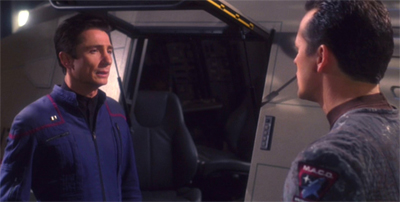


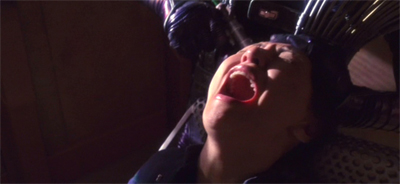
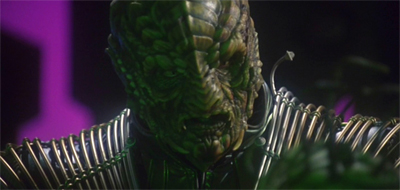



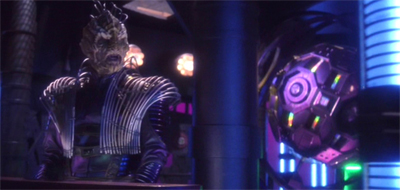





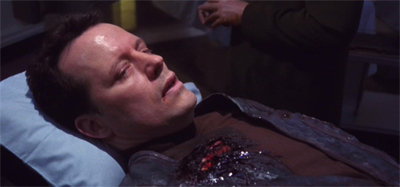







‘Writing stiff’ may be the best and most appropriate typo ever. 🙂
Another great review Darren. I confess I wasn’t watching Enterprise at the time (though I did come back for the next season) but I’m stunned to hear they might have killed off Archer this late in the game, especially for someone (ugh) hipper.
Good spot, Ross! I’ll correct that now!
Truth be told, I think killing the captain would be an interesting narrative trick for a Star Trek show, although less so in a post-Game of Thrones world. Imagine a first season set up with a captain, only to kill them off in the finalé, upsetting the crew dynamic in the second season.
Of course, Zero Hour would have been the worst time to kill off Archer, because there’s no way that UPN would have allowed the production team to have any real input into the new commanding officer. You can almost hear the marketing buzz words. “Hipper” is one of the less cringe-inducing ones. (“Think of him as a four-quadrant captain!”)
(“And Starring Freddie Prinze Jr. as Captain Lucas ‘Balls to the Wall’ Ballzer.”)
Heh. 🙂
I’m a Scott Bakula fan so I’m glad they didn’t (and I say that has someone who saw ‘She’s All That’ more than once in cinemas) but I think an actual alien captain as series lead would have been an interesting change for a Star Trek show.
Yep. I’m wary of what UPN would have let them get away with though. I can imagine an actor too young and “hot” to risk covering in make-up.
” Imagine a first season set up with a captain, only to kill them off”
Babylon Five flirted with that. The replacement was sort of shoe-horned into ready made scripts. He was introduced as a harder, more driven character but it took a few episodes (a season, really) for that to come into play. In the meantime he shared too many traits with his predecessor. Sinclair was a Jesuit, so Sheridan spent time in Tibet.
Still, it is/was interesting to see the lead get swapped out after so much build up. I wouldn’t mind seeing it done again, preferably to an actor I’d miss.
I thought there were some actor issues on Babylon Five that forced the change?
But, yeah, I’d love to see Fuller play with something like that. Plus, killing the captain means growing the crew. Actual change to the dynamic of the show.
“UPN very clearly wanted a version of Star Trek that skewed younger. They wanted a sexier action-driven show.”
This was one of the most irritating things about Enterprise, the way they pushed away so many viewers for the sake of a tiny demographic. Voyager aired when I was age 5 thru 11. My family always got together as an occasion to watch new episodes of the show. It was something inoffensive that everyone could enjoy. When the Enterprise pilot rolled around, I was 11, and it became clear with the decontamination gel rub scenes and this was no longer a family show. Being that young, those scenes were very uncomfortable to watch, especially next to my mom and dad. This sort of ended Star Trek night, and I’d only catch an episode here and there on my private TV until I gave up on the show for being boring. It was only after ENT episodes ended up on youtube that I really watched the entire series.
The same is true of me, although I would have been a little over eleven. But my family made a point to watch “event” episodes together. So we watched What You Leave Behind, Endgame, Broken Bow. Broken Bow was definitely the last one we watched. Well, apart from the JJ Abrams Star Trek films.
Yeah, the Abrams movies (and Discovery, from the look of it) vindicate a fair amount of Enterprise’s last two seasons. Sad then, that it ends with such a defeated sigh in These Are the Voyages. Also nice to see the Insectoid Xindi finally get a little sympathy, even if it’s pretty much too little too late haha
Yep.
“We have second thoughts about th–”
BOOM.
I was intrigued by the dynamic between Reed and Hayes, and their shared distress over the loss of Cpl Hawkins. It seemed more than losing a colleague or subordinate. And then their last moments together in Sick Bay.
Yep. I really like the Reed/Hayes stuff in this season. However, I am admittedly something of a Reed fan. So mileage varies.